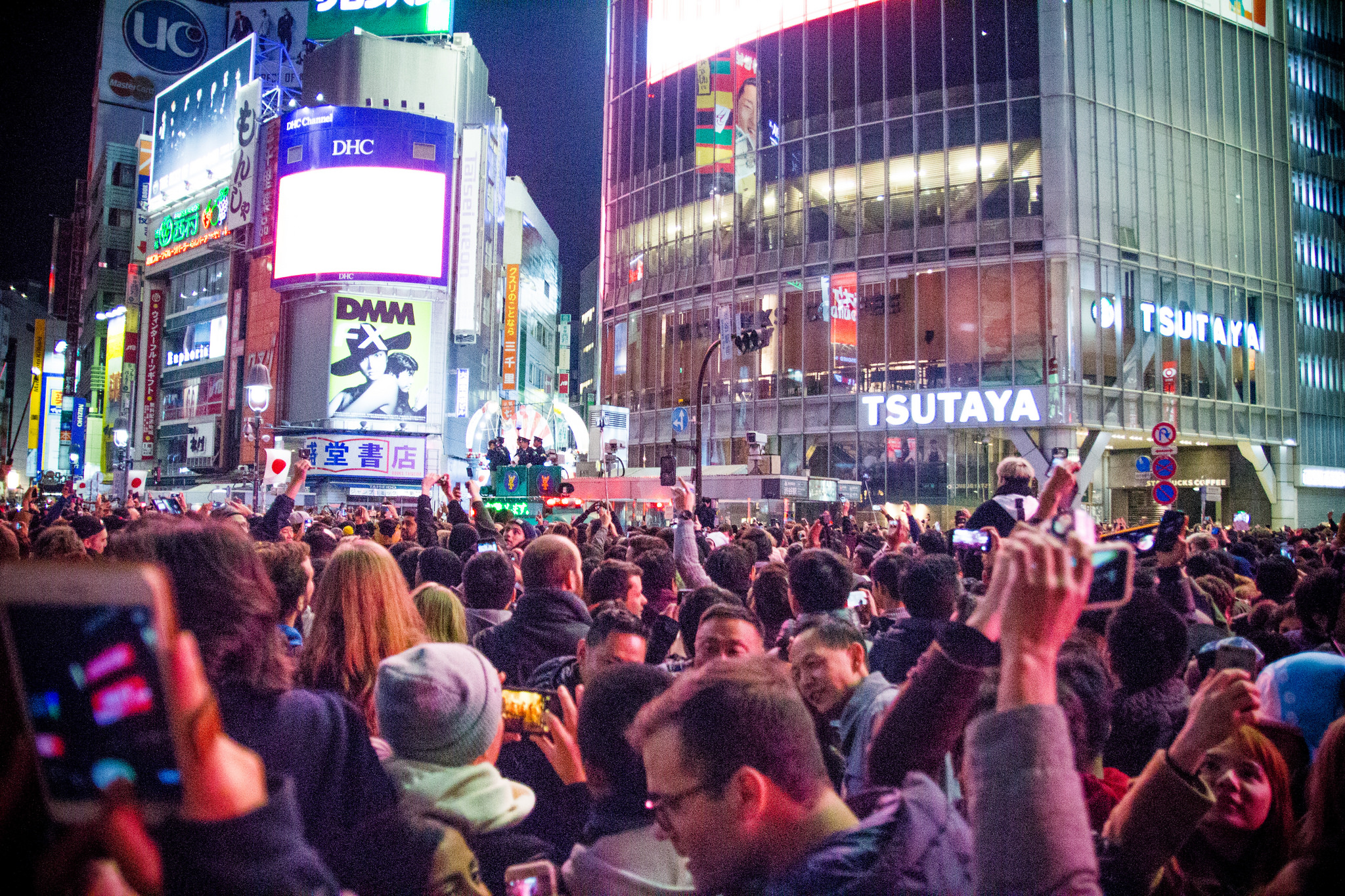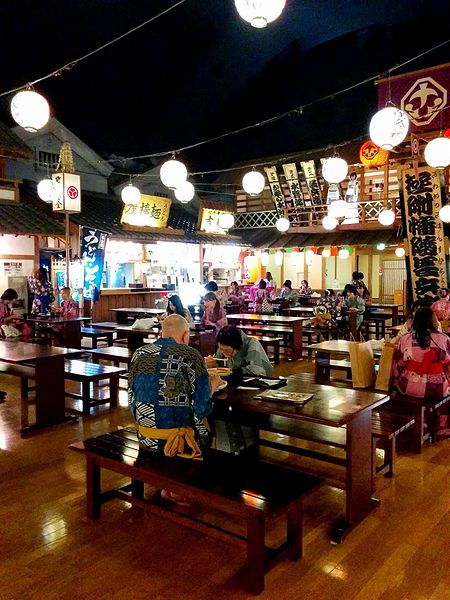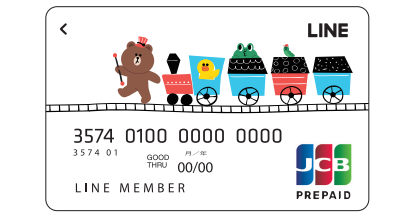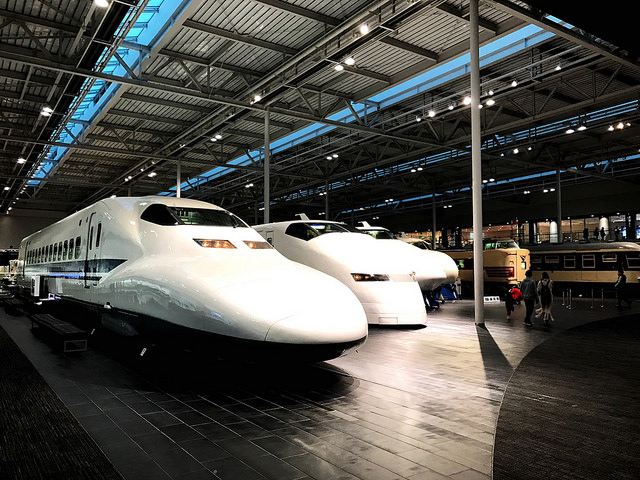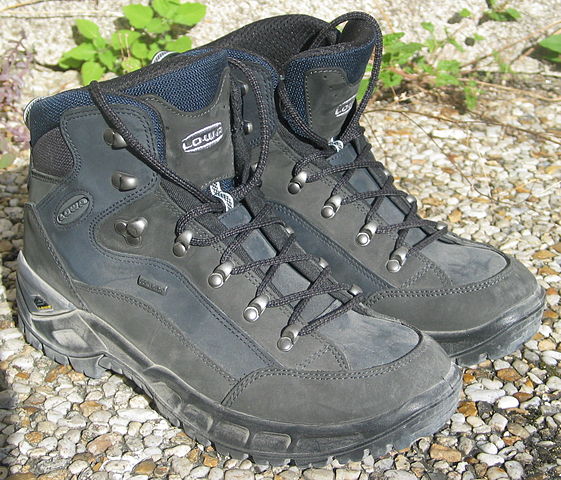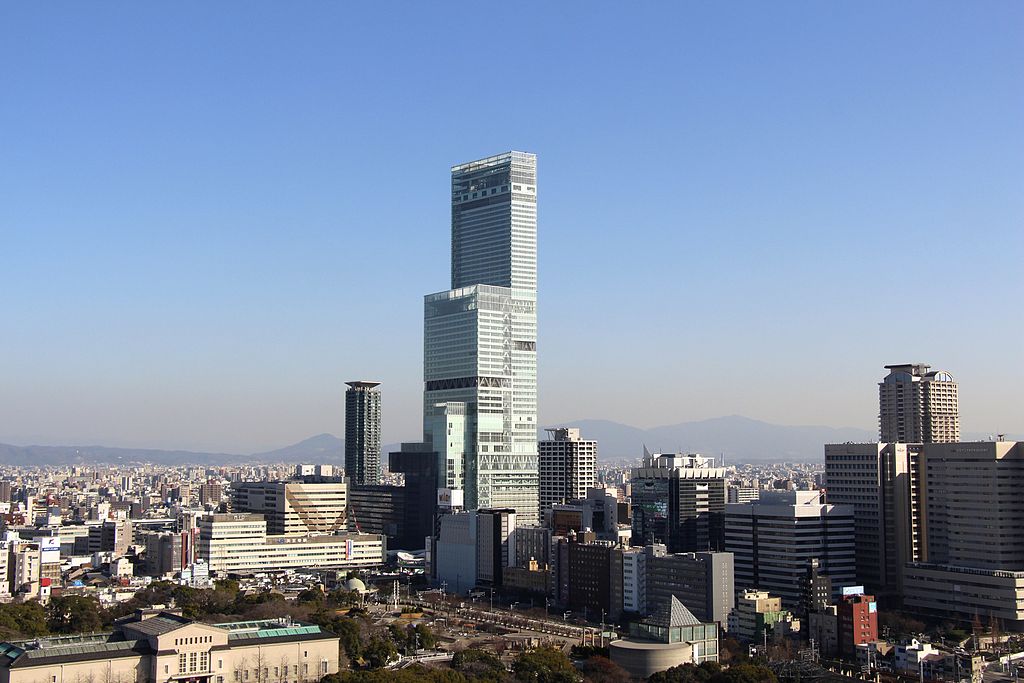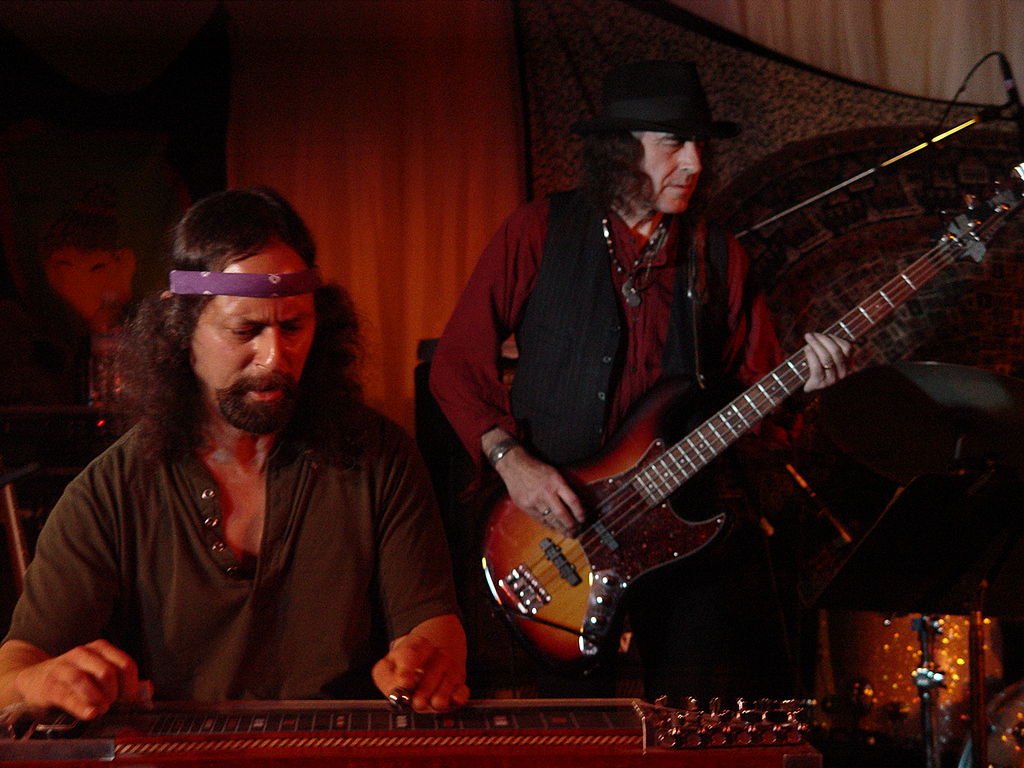Nov 29, 2017
New Year’s Countdown Tokyo Style 2017

Revelers await the coming new year as time ticks down on the video monitors above Shibuya Crossing. (Dick Thomas Johnson via Flickr)
Whoa, can you believe it? Another year is almost on its way out and as always, your ever faithful JIS staff are here to inform you about the places you can wave bye-bye to 2017 and welcome 2018 with open arms! Now as you may or may not know Japan does celebrate New Year’s Day, the locals tend to do it more calmly by gathering with family and friends and watching hours of TV specials (Kohaku Uta Gassen and Warate wa Ikenai are my favorites). However just as you may have noticed with Halloween, You can find numerous “countdown parties” all over Tokyo, and there’s sure to be one that will fit your style. Here’s a small sampling:
AGEHA
If you want to bring in 2018 by raging like a rockstar in a music video, this is the place to do it. Over 1000 people can party on its multiple dance floors at once, and in addition to it being in close proximity to Shin-Kiba station; there’s a free shuttle bus from Shibuya that can also get you over there. Check their website for more details and prices.
Tokyo Disneyland/Disney Sea
If you’re looking for something more family-friendly, The Happiest Place in Japan has got your back; If you enter the resort at 8pm or later on December 31st, you ca stay until 7:00am on January 1st. Also you can start off at either Disneyland or Disney Sea, then at 1:00AM you are able to hop between the parks; usually you’d need a special ticket (and more money) to do that! Check here for details and transport options.
Shibuya
Perhaps you’ve seen on TV or have had the experience of either being out in the crowds of a large public square, watching the time countdown on large video monitors and cheering with thousands of total strangers when it gets to zero. If that’s what you’re into, then head over to Shibuya Crossing where the streets will be blocked off and every bar and nightclub in the area will be ready to accommodate you into the new year. Expect a scene not unlike Times Square in New York City, and because the trains are running all night (the only night of the year they do so,) you don’t have to wait until dawn to get a lift home. But that’s no fun, right?
Image by Dick Thomas Johnson YOU MAKE SHIBUYA COUNTDOWN 2016-2017 (CC BY 2.0)
Nov 29, 2017
Super Sento and the art of relaxation in Tokyo
It’s no secret that Japan is one of the most seismically active places on Earth. But this is also a good thing when you take one of the country’s most valuable assets into consideration: the Onsen, which is Japanese for hot spring. You can find hot springs all over Japan, and indeed whole towns have been known to capitalize off of their proximity to the geothermal boilers. However if you live the Greater Tokyo Area, you know that the chances of finding one of these natural pools is slim to none.
There are 3 choices for springs lovers in urban settings:
- Take a mini-vacation to places like Atami, Hakone, and Izu in Kanagawa prefecture, or to Gunma or Tochigi prefecture. These places are known for having good onsen hotels and depending on the season, you can also ski, snowboard, hike, and more. The water coming out of the ground is rich in minerals and other healing agents and its naturally heated to perfection by Mother Earth. Many of these places are resorts so they provide soap, towels, shaving kits and more. Some also have very good restaurants attached to them.
- Go visit your local “sento” meaning Japanese bathhouse. You can find these places in most areas around Tokyo, especially older “shitamachi” areas like Asakusa, Senju, and Kanda. I even spotted one in Ginza recently. These places were originally made out of necessity because a lot of homes didn’t have enough space for a tub or even hot water! So every neighborhood had a bathhouse. Because of this, most sento lean heavilly utilitarian in the way of facilities: places to wash up, a big rectangular tub for 8-14 people to sit in, and that’s it. You bring your own toiletries and soap.
- The “Super Sento” or “Super Spa”. These are a mixture of #1 & #2 and this author’s personal favorite when wanting to relax. Imagine a ginormous sento or a country onsen that decided to move to the city and snag a penthouse apartment.
The “Super Sento” brings all the amenities of a countryside hot springs resort into the middle of town.
Manyo Club Onsen in Yokohama
Located in Yokohama’s Minato-Mirai district right across the street from its iconic Ferris Wheel, 万葉倶楽部 or “Manyo Club” is a great place to relax after touring the nearby Chinatown and Red Brick Warehouse areas. Located just a short 5 minute walk away from the Minato-Mirai line station of the same name, it carries all the amenities of a fine countryside hot springs hotel but with dramatic views of the Yokohama seaside. Actually, if you want to stay overnight or even over several days, there is an attached hotel as well.
The main draw of course is the onsen. This is a true spring; the water is trucked in 6 times a day from springs in Atami and Yugawara, spitting distance from Mt. Fuji. There are a variety of pools to soak your stress away in, from the usual and very large indoor tubs, to various rooftop outdoor pools overlooking the Minato Mirai district. There are even private tubs that are rented by the hour for those who want some “private time” with family or significant other.
In addition to the onsen, there are several other amenities as well:
- Full service restaurants, both buffet and set menu style
- Manga reading room and Internet cafe
- Traditional Thai massage and British style reflexology services
- Dry, salt, and herbal sauna rooms
- Gift shop, meeting rooms, banquet hall rentals and more
Manyo Club is located just 30 minutes by express train from central Tokyo and can be reached directly by using either Minato Mirai station on the Minato Mirai line (Tokyu Toyoko line), or Sakuragi-cho station on JR’s Keihin-Tohoku and Negishi lines and the Yokohama City Subway Blue line. There is also free shuttle service that operates between Yokohama station and the resort from 10am until 11pm hourly.
Opening Hours: 10:00-9:00 (the following morning) Open everyday
Address: 2-7-1, Shinko, Naka-ku, Yokohama, 231-0001 (map link)
Closest Railway Station:
Sakuragicho Station: JR Keihin Tohoku Negishi Line / Municipal Subway Line
Minatomirai Station: Minatomirai Line
Tel: 045-663-4126
Ticket Info
Set admission (hours from 10:00 am – 09:00 the following morning)
Adults (older than Junior High School): 2,620 yen
Children (Elementary School Students): 1,470 yen
Children (3 to under school age): 980 yen
Children under 3: Free.
Credit Cards: all major cards accepted
Languages Spoken: Japanese, English
Odaiba Oedo Onsen Monogatari
 Anything built on Odaiba Island in the middle of the Tokyo Bay shoreline automatically qualifies for over-the-top status. This is no different. They say “everyday is a festival here” as a tagline, and the second you walk in, it’s like being transported into any Spirited Away bathhouse scene. Once you’ve entered, head to the changing room and swap your street wear for a yukata, and you’re ready to stroll around the complex which is set up like a small Edo-era village in the middle of summer festival season.
Anything built on Odaiba Island in the middle of the Tokyo Bay shoreline automatically qualifies for over-the-top status. This is no different. They say “everyday is a festival here” as a tagline, and the second you walk in, it’s like being transported into any Spirited Away bathhouse scene. Once you’ve entered, head to the changing room and swap your street wear for a yukata, and you’re ready to stroll around the complex which is set up like a small Edo-era village in the middle of summer festival season.
Fees:
Weekdays M~F Adult: JPY2,480
Weekends, Holidays Adults: 2680~2,880JPY
Late Night Discount Entry: 2,000 JPY
Children: JPY1,000 (rate doesn’t vary)
Amenities: Japanese Restaurant, Game Corner, Fortune Telling, Massage, Sauna, Day Spa, TV room, Capsule Hotel
Hours: Open Everyday 7/365, closes 9am~11am for maintenance.
Access: Yurikamome Line, Telecom Center station, 2 min. walk
Address: 135-0064 Tōkyō-to, Kōtō-ku, Aomi, 2 Chome 6-6-3 (map link)
Saya no Yudokoro at Maenohara Onsen

Maenohara Onsen/Saya no Yudokoro
(via website)
A true-to-life hot spring oasis in Tokyo’s Itabashi Ward, the natural waters found here have been used for relaxation first by a fairly rich family as this was their private estate. Then in 1946, they decided to open it up to the public to enjoy…for a fee of course. Fast forward 70 or so years and while the neighborhood around it has grown and urbanized, the onsen itself has been renovated in all its Showa Era glory.
Unlike many other super sento in Tokyo, Saya no Yudokoro’s waters come from 1500 meters directly underground and are naturally high in sodium chloride content which gives its water a greenish tint. It’s said to be good for those suffering from arthritis and poor circulation. I suffer from neither, but did note my usually stiff shoulders were very loose by the time I got out! Another noteworthy point is the Japanese gardens surrounding the facility. It is incredibly hard to remember that you’re still in the middle of Tokyo when strolling the grounds sipping a hot cup of green tea from the restaurant inside. That restaurant serves traditional Japanese cuisine like tempura, udon, and more; nothing beats a nice meal after soaking in the springs… Or are you a “eat-before-soak-after” type?
URL: www.sayanoyudokoro.co.jp/english
Fees:
Weekdays M~F Adult: JPY830, Children: JPY520
Weekends, Holidays Adults: 1030, Children: JPY720
Amenities: Japanese Restaurant, Massage, Sauna, Aroma Therapy
Hours: 10:00am~1:00am (next day)
Access: Mita Subway Line, Shimura-Sakanoue Station, Exit A2, 8 min. walk
Address: 3 Chome-41-1 Maenochō, Itabashi-ku, Tōkyō-to 174-0063 (map link)
Image by: Jason Gatewood
Image by: Oedo Onsen Monogatari Interior by Ronny Siegel (Own work) [CC BY 4.0], via Wikimedia Commons
Image by: Maenohara Onsen/Saya no Yudokoro (via website www.sayanoyudokoro.co.jp
Nov 23, 2017
Line Pay Card: A Cure For Your Lack of Debit Card Woes

One of the 5 Line Pay Card designs you can choose.
(Line Corporation)
If you’re like most people coming from America, you are probably used to pulling out the plastic whenever buying incidentals like your morning coffee, a candy bar or an order of Chicken McNuggets. That’s because pretty much every bank in the US has some sort of debit card that works on a major credit card company’s network that pulls money directly from your bank account at the time of the sale transaction. These cards may have replaced the traditional ATM only cash card in many places around the word, from Hamburg to Hong Kong, but not here in Japan where cash is still king in many places. The landscape is changing however and many places like convenience stores, fast food chains, and other merchants are accepting them in more places than ever before.
The major sticking point is the lack of debit cards that work with these systems. At the time this article is being put together, only MUFG, SMBC, Rakuten and JapanNet banks seem to have them. Another alternative is to use a reloadable debit card. These are cards that you can load manually with cash either by going to a convenience store, using an ATM, or connecting it to your bank account and transferring money. This at first may seem like more of a hassle rather than the set-it-and-forget-it nature of traditional debit cards, but it actually gives you more control in the long run.
There are many brands of card out there but my #1 pick is the Line Pay card. There’s almost no escaping the reach of LINE, the Made-In-Japan (by way of Korea) instant messenger turned social media network. Literally everyone and their dog uses it, and if you’re in Japan you more than likely using it to communicate to everyone here as well. The app recently debuted its own JCB debit card tied to your Line Pay and Cash account. The beauty of this card is that the management of the whole account lies within your LINE app on your smartphone… Oh, and it’s in ENGLISH as well! One other bonus lies in the fact that you accumulate points as you use the card, just like a regular credit card.
Step 1: Getting the card
First you need a LINE account, and it has to be tied to a Japanese mobile phone number. These are the only requirements, so that also means you can use it for your children and load their pocket money on it. Next, simply navigate into the Line Pay tab in the app and apply for the card. Make sure to pick a cool design!
Step 2: Receiving the card and activation
You should get your new card in the mail in under a week. Activating is dead simple; just use the LINE app to scan the QR code on the letter the card is attached to, and the card is ready for use.
Step 3: Loading the card with money
There are many ways to keep the card topped off with cash, and each method is described in detail within the LINE app _in English_ so you’re never at a loss as to how to do any of them. The simplest method is to head over to a 7-11 ATM, insert the card and feed the machine with some yen notes. Once finished, you should get a message in LINE telling you the new balance and that’s that. Another easy way is to go to Lawson’s and just hand your card to the clerk along with some money and say “charge my card please” (charge in Japan means to put money on the card, not pay for something like elsewhere.)

Instructions for loading the card with cash and paying via the LINE app.
(Line Corporation)
If these options aren’t available, then you can use almost any convenience store’s kiosk or use any bank ATM and the Pay-Easy system, but be sure to read through the instructions in the app first; many of those store and bank systems are only in Japanese but the instructions given on how to use them are pretty thorough. Lastly, you can tie your bank account directly to the Line Pay app itself and then initiate transfers to keep you cashed up. This only works with a limited amount of banks at this point, but the major ones are covered including Japan Post. (If you don’t have a JP account, get one– you can find a post office )
Step 4: Keeping track of it all
It’s easy to tell what’s happening with your account since every transaction shows up in a chat thread between you and the card. If you need help with anything, you can also chat with a customer service representative as well (yay human interaction!).
Step 5: Bonus points!
Everytime you use the card, you get 2% worth the transaction fee in LINE points, which are used as currency for LINE services. Of course you can use them to buy content like stickers and music, but also the points can be use with their shopping and delivery services as well as exchanged for other point systems (Rakuten Points, T-Points, etc), or when tied to a bank account, a cash-back bonus.
Step 6: One more thing…
For the iPhone users out there, this card can’t be used in your Apple Pay Wallet, but it can be used to recharge your Mobile Suica inside the app itself. This is useful for those times when you’re late for your train and don’t have time to manually recharge it, or if you’re already aboard and realize you didn’t have enough money loaded up.
Nov 22, 2017
Whisky Lovers Nagoya

Recently, whisky is much more popular here in Japan than it was a decade ago. The TV drama “Massan” (story of Nikka whisky) is perhaps the key to this whisky boom, and the reason why there are now so many whisky events in Japan… but not Nagoya. (Mostly Tokyo, Osaka and Kobe) This event is the only whisky event in Nagoya, so whisky lovers in Nagoya can’t miss it!
100 booths (last year 60 booths!) offer you a taste of many kinds of whiskys from all over the world. Some rare whisky or expensive whisky will cost between 100 JPY and 1000 JPY, and offer some some foods too.
Whisky Lovers Nagoya 2018
- Sunday, 21 January 2018 from 11:00~17:00
- Place: Fukiage Hall (3min walk from Fukiage-station)
2-6-3 Fukiage, Chikusa Ward, Nagoya, Aichi Prefecture 464-0856 (map) - Tickets 3500 JPY in advance (including neck strap and original glass)
Tickets on the day 5000 JPY (only including strap) - https://wln.themedia.jp/posts/2471618 (JP)
- www.facebook.com/whiskyloversnagoya (JP)
Nov 21, 2017
Nagoya’s German Market
With its strawberries on cakes, love hotels and KFC, Japan gives Christmas a good try, but it doesn’t quite come out right. What we need at this time of year is some real, good old fashioned tradition, and nothing quite screams ‘IIIIIIIIIT’S CHRRIIIIIIIISTMAAAAAAAAAAAAS‘ like handmade wooden toys, excited children and the scent of hot, mulled Glühwein.
Thank Christ (literally?) for Nagoya’s annual German Christmas Market.
About the Christmas Market
Every year at Hisaya Hiroba in Hisaya-Odori Park, a German themed market brings a sprinkling of Christmas tradition to Nagoya. This year, from December 9th until Christmas Day, the market will be open every day, with its various Christmas events.
You can get some of your last minute Christmas shopping done at one of the many stalls selling handmade crafts, decorations, clothes and trinkets, but be warned that if you are with children you might not have much time for shopping, as you will no doubt be dragged off to marvel at the huge christmas tree, ride on the merry-go-round and then, of course meet Santa!
There’s a good chance you’ll be hungry after all that excitement, so you should make your way over to the food stalls stocked with classic German food such as sausages, pretzels, sausages, mashed potato, sausages, delicious cakes and sausages. To wash down all of that delicious, wintery food you can get great foaming German beers or the aforementioned Glühwein to warm your insides and fill you with a great deal of Christmas cheer as you watch one of the festive dance and musical performances on the stage.
German Christmas Market Details
- Where: Naka Ward, Sakae, 3 Chome−16 (map)
- When: December 9 – December 25, 2017; Weekday 12:00-20:00, Saturday, Sunday, national holiday, December 24-25, 11:00-20:00
- Stage Shows: Weekday 18:00-, 19:30; Saturday Sunday, national holiday 13:30-, 15:00-, 16:30, 18:00-, 19:30-
German restaurants in Nagoya
If that’s not enough Germanness for you, perhaps you want to check out one of these German restaurants in Nagoya.
Zur Deele German Restaurant
Zur Deele is a bit fancy, serving superb food prepared by a chef who trained in Germany for five years. The exterior is stately brick house surrounded by a cozy garden, and after entering you walk over a satiny floor to the main dining room, to which the restaurant’s name ‘Zur Deele’ alludes. The staff recommends the homemade cured ham and sausage, but all selections use the best seasonal ingredients. Don’t for get the stock of German wine!
- Where: 6 Chome-15 Mizuhotori, Mizuho Ward (map)
- Website: zurdeele.co.jp
Doitsu-Un German Restaurant
Doitsu-un was recommended by a German friend of JIS and described as “the most authentic in Nagoya.” Doitsu-un is actually in Ichinomiya City, but as that’s just a 20 minute train ride from Nagoya it might be worth a jaunt out for a taste test. It is a bit pricey at about JPY 2500 per person (if not more), but you get what you pay for.
- Where: 2 Chome-6-10 Honmachi, Ichinomiya (map)
- Website: tabelog.com
Gengenbach
A five minute walk from Meieki, Gengenbach is as close to a German bierkeller that you are likely to find in Nagoya. It’s underground, dark and wood-lined and has a huge array of German beers. There is oompah music played overhead, sausages aplenty, and on a Friday and Saturday night, as it starts to fill up and the beer flows, you could just well be in the middle of Berlin.
- Where: Nakamura-ku, Meieki 4 Chome 2-28, Nagoya Dai Ni, Saitama Building B1 (map)
- Website: bar-espana.net/gengenbach
Alsace German Restaurant/Deli
Finally, if you are in the market for some decent German food to work with at home you are going to need some meat. Though we would normally recommend any meat you purchase be from the Meat Guy, this is an exception. Alsace is deli specializing in German Style meat in Mio Kaguyama Shopping Center in Nisshin that you should definitely check out.
- Where: 5 Chome-1801 Kaguyama, Nisshin (map)
- Website: alsace.co.jp
Image by Charlotte Tai (Own work) [CC BY-SA 2.0], via flickr.com (modified)
Nov 21, 2017
Places of Worship in Nagoya
While religion in Japan predominantly based around the various sects of Shintoism and Buddhism, it is a country that is highly tolerant of other religions. Outside of the classic Japanese beliefs the most are followers of the various Christianity orders, with about 3 million Christians in the country. Studies put the number of Muslims in Japan between 70,000 and 185,000, 90 per cent of which are foreigners and the majority of the remaining 10 per cent being Japanese nationals who have married foreign Muslims. There are believed to be around 2,000 Jewish people living in Japan after many of the country’s Jewish population moved to Israel following the nation’s creation after World War Two.
Worshiping around Nagoya
Below is a list of some of the places of worship around Nagoya of various denominations.
Nagoya All Saints International Church
Weekly opportunity for personal renewal, spiritual growth and soulful refreshment. All are welcome. Worship in English 17:00 every Sun., followed by fellowship. Located in Imaike nearest to Imaike station, exit 9.
- Where: 3 Chome-5-19 Imaike, Chikusa-ku, Nagoya-shi, Aichi-ken 464-0850 ( map )
- Website: nagoyaallsaintsinternationalchurch.com
Nagoya Union Church
Join with Christians from many countries for worship & fellowship in English. Bible studies, small groups and Sunday school also available.
- Where: 22-12 Daikan-cho Higashi-ku (map)
- Website: nagoyaunionchurch.com
Nagoya Orthodox Church, Holy Theophany Church
Every Sunday, around 30 Christians gather and share Holy Communion.
- Where: Yamawaki-cho 1-3-3, Showa-ku (map)
- Website: orthodox-jp.com/nagoya
All Nations Fellowship
All Nations Fellowship is a bilingual church for people of all ages and from all kinds of backgrounds. They value strong community, Christ-centered teaching and want to bring God’s love to the people of Japan and the world.
- Where: 1601 Fujisatochō, Meitō-ku, (map); Nakamura-ku, Taikō, 1 Chome−4 (map)
- Website: allnationsfellowship.net
Nagoya International Baptist Church
TNIBC are an Independent Fundamental Baptist church. They believe in the absolute authority of the Bible as the inspired Word of God for all doctrine and practice.
- Where: 5-115 Tsuchihara, Tenpaku-ku (map)
- Website: nibc.japanforchrist.com
Nagoya Mosque
Nagoya was reportedly the first place of worship for Muslims in Japan. Nagoya Mosque hosts Friday Prayers and is open for five-time prayers
- Where: 2-26-7 Honjindori, Nakamura-ku (map)
- Website: en.nagoyamosque.com
Nagoya Port Mosque
Open for five time prayers every Saturday with a special speech and dinner after Isha Prayer. Children’s Arabic lessons on Saturdays
- Where: 33-3 Zennancho, Minato Ward (map)
- Contact: 052-384-2424
Jewish Community of Japan
There is no synagogue in Nagoya, however the Jewish Community of Japan can be found here.
For a fuller list of Nagoya’s places of worship, head to the excellent Nagoya International Center’s website here.
Image by Anne Hope (Own work) [CC BY-SA 2.0], via flickr.com (modified)
Nov 21, 2017
Riding the Rails at Nagoya’s SCMAGLEV and Railway Park
As you may have noticed, Japan has something of an obsession with trains and railway. Ever since Commander Perry gave a gift of a small locomotive car to the ruling Shogunate in 1854, the Japanese have been captivated by all things railway.
In Nagoya this fascination is expected to reach fever pitch over the coming years as the arrival of the magnetically levitated bullet train (maglev), that will be able to hit maximum speeds of 505 km, is awaited with baited breath.
Unfortunately that is a full 10 years away, but that doesn’t mean there is no need to get excited. It just means that until then we will have to get our train fix at the SCMAGLEV and Railway Park.
About the SCMAGLEV and Railway Park
Opened in 2011, the SCMAGLEV and Railway Park is a museum exhibiting the history – and future – of Japan Central Railways. Focusing mainly on the Tokaido Shinkansen (Bullet Train), the museum aims at entertaining and educating visitors in the advances in high speed rail in Japan down the ages.
The exhibition includes collection of 39 retired train cars from various periods of Japan’s rail travel history, from steam locomotives to the latest designs of the high-speed maglev, some of which are famed for having broken world speed records. Many of these can be entered or viewed from below, all with explanations of the different parts of the trains, their operation and maintenance.
The museum houses one of Japan’s largest train dioramas, which should delight all, but particularly younger children, with miniature trains running through detailed recreations of Osaka, Nagoya and Tokyo.
Other fun items for children includes the simulators*, with a life-size mock-up of the driver’s cabin for the Series N700 of the Tokaido Shinkansen and a Conventional Train Driving Simulator where users can open and close the doors and give train announcements between stations.
There are also various learning zones such as the Railway System Learning Zone that explains the history and evolution of the high-speed railway, a Railway History room that focuses on all advancements in train travel along the Tokaido line, and a Relics Room that hosts historical documents and objects, such as old tools and equipment from the bygone era of travel. Another great attraction for children is the Learning and Experiencing Room where kids can use models to seeing how the science that they have learned in school is applied to the world of the railway.
While a lot of the exhibition is in Japanese, there is an excellent English audio guide (as well as in Chinese, Korean, French, German, Spanish and Portuguese) available for 500 yen, providing detailed explanations of all of the museum exhibits.
Details
- Where: 3 Chome-2-2 Kinjofuto, Minato Ward (map)
- When: 10:00-17:00; closed Tuesdays and December 28 to Jan 1
- Admission: Adult 1,000 JPY; school child 500 JPY; child 3+ 200 JPY
- Website: museum.jr-central.co.jp
* Simulators are charged an additional fee of between 100 and 500 JPY. Reservations must be made in advance at the museum information desk and are determined by a lottery system which takes place four times per day. Entries must be submitted at least 45 minutes in advance.
By Mark Guthrie
Image by ポトフ (Own work) [CC BY-SA 2.0], via flickr.com (modified)
Image by Shinji W (Own work) [CC BY-SA 2.0], via flickr.com (modified)
Nov 21, 2017
The great outdoors (and some mountains) right in Hiroshima City

If you like the outdoors and fall into one of these categories:
- are new to hiking, that is, inexperienced;
- don’t have a great level of fitness;
- want to take your kids on a hike with you, but don’t plan on carrying them or
- have exhausted all other hiking trails around Hiroshima,
then hiking Mt. Mitate and/or Mt. Ushita are for you. In other words, it’s an easy track suitable for people of any age and any fitness level.
When someone told me a hike, I’d envisioned a lot harder; strenuous even. I did it with 11 four and 5-year-olds and I wasn’t sure how they’d go… No problem. And no, I don’t have 11 kids; they’re my students. Perhaps, best of all, it’s easy to access as it’s right behind Big Wave, which you can reach via the Astram Line (Ushita Station).
When you leave Ushita Station, head towards Big Wave through the park at the front of it. On the right of the building you’ll see a small access road leading up to an open-space grassed carpark. Cut across the grass and make your way up the stairs at the end of the road. You have to use your leg muscles to get up the hill, but if short, little legs can do it, you’ll be just fine!
You’ll reach a rose garden (and the first lot of toilets) which is also a picturesque stop either on the way up or down. Following the road past the garden you’ll come to the second set of toilets. My advice is to go here, especially if you have children, because there’s nothing available after that.
Head up the road to the left and across the bridge to the actual trail. The steps may be steep, but they’re well maintained. As an Aussie who’s used to beating her way through bushland with little or no tracks, Japanese hiking doesn’t seem like hiking, especially when there are man-made steps along the way. Still, it’s sort of nice in a way.
You’ll eventually reach a sign with some very steep stairs. Go up the stairs and then choose either the left route to Mt. Ushita or the right one to Mt. Mitate. Although both mountains aren’t particularly high, 134.9m (Mitate) and 260.6m respectively, the view from the top is well worth it.
The gazebo at the top of the very steep stairs is a good place for a picnic lunch and the view, even from there is lovely, as it looks over Hiroshima and out to the islands.
At 1.5km each way, it’s an easy option to get some fresh air and exercise without wearing yourself (or the little ones) out, too much.
By DocteurCosmos (Own work) [GFDL or CC BY-SA 3.0], via Wikimedia Commons
Nov 21, 2017
Kansai or Kanto? Who Ya Got?

“You despise me, don’t you Rick?” says Peter Lorre’s Ugarte to Humphrey Bogart’s Richard Blaine in Casablanca. “If I gave you any thought I probably would,” replies Bogart dismissively, deflating his presumed rival.
The exchange is reminiscent of the regional rivalry that divides Eastern Japan (Kanto and Tokyo) and Western Japan (Kansai and Osaka). Tokyo has four times as many people as Osaka and, as may be heard around Kansai, thinks it represents Japan. To Kanto, if they are forced to deal with Osakans at all, they will typically think them a coarser, more money-hungry lot. It is mostly a friendly rivalry but things were not always so tonque-in-cheek.
The Earliest Rifts
Kansai is where Japan coalesced from a collection of feudal societies into a modern-looking city-state developed around a sophisticated commercial system and trading centre. The traditional home of the Emperor of Japan was in Kansai for over 1000 years. In 1868 the government seat moved to Tokyo and the fracture between the two regions began to appear.
Tokyo was ruled by the samurai warriors while Osaka remained the home of wheeler and dealer merchants. The samurai would evolve into button-downed government bureaucrats in the 20th century loath to challenge the strict rules of society that they were brought up to represent. In Osaka meanwhile, only about 10 percent chose the samurai lifestyle and the remainder chafed against increasing national regulations that targeted their business-fueled lifestyles.
In Osaka, the common greeting on the street was not “Konnichiwa” (hello) but “Mokarimakka” (are you making any money?). The carryover of this attitude can be seen today. It is not unusual for an Osaka-based company to be successful in Tokyo but the reverse is much-less common. The usual explanation is that businesses of Tokyo origin are often used to their dealings being entwined with the government and they can struggle in the free-spirited Kansai marketplace.
Is It Kanto or Kansai?
The cultural divide between the two region manifests itself across everyday life. Riding an escalator in Japan? In Kanto, stand on the left side. In Kansai, stand on the right. It’s something about samurai preferring to approach strangers from the left to keep their sword hands ready while Osakan merchants would prefer to keep their wallets away from the flow of traffic.
Walking the big city streets in Japan? In Tokyo, pedestrians will stand obediently on an empty street waiting for approval to cross – much like their strait-laced, rules-addled samurai ancestors. In Osaka, barreling into traffic is the order of the day, like a businessman rushing to close a deal.
There are inter-regional dust-ups in sports (Tokyo’s Yomiuri Giants vs. Osaka’s Hanshin Tigers in baseball); language (a formal dialect the Kanto folks consider standard Japanese vs. a street-infused communication in Kansai); fashion (a more individual appearance in Kansai vs. the dedicated followers of fashion in Kanto); food (in just about everything from the amount of salt to the amount of spiciness); to a sense of humor (guess which region prefers slapstick and which strait-laced region doesn’t?).
The internecine flare-ups between Kanto and Kansai have been going on for centuries with no signs of dissipating. How can you tell? The marriage rate between those raised in Kanto and those reared in Kansai is only 10 percent. People will no doubt be staking out their allegiances for years to come.
By Kanchi1979 (Own work) [CC BY-SA 4.0], via Wikimedia Commons
Nov 21, 2017
Kansai’s Pivotal Role in Japanese Folk Rock

The 1960s have been immortalized as a time of cultural revolution in places like the United States and Europe. If anything the disruption was even greater in Japanese society. The country was awash in American culture after a generation of United States military influence in the years after World War II. Jazz and rock-and-roll dominated radio airwaves, pushing aside Japan’s traditionally tightly controlled music industry.
When the Beatles arrived for a set of five concerts in Tokyo’s Nippon Budokan Hall in 1966 (amidst death threats from Japanese traditionalists) the group used all local artists as opening acts. Their appearance was credited with energizing the country’s youth in charting a life course not dictated by their families. Afterwards Japan’s large cities began experiencing upheavals and protests not unlike urban centers in the West. This subversive underground movement of the youth culture got its own name: angura.
Kansai’s Contribution to the New Music Scene
While young Japanese musicians and college students were imprinting their rejections of the traditional past in Tokyo clubs, a different musical subculture was evolving in the Kansai hubs of Kobe, Osaka, and Kyoto. The artists were more political and the folk rock songs that emerged carried messages of protests.
The center of the Kansai underground music scene in the late 1960s and 1970s was a bar called The Dylan II, a club operated by a band of the same name. Acts that would appear included the progressive folk rock group Itsutsu No Akai Fuusen whose original members – Takashi Nishioka, Hideko Fujiwara, Junji Ariyama, and Isato Nakagawa – eventually released 16 albums.
Other central figures of the Kansai folk-music boom included Ryo Kagawa, who began his career in a Beatles cover band and passed away this year at the age of 70. Kagawa sang his way into the national consciousness with an anti-war anthem called “Kyokun I.” Kagawa was preaching anti-patriotism at a time when many of his contemporaries shunned individualism. Another Kansai protest singer, later turned actor, was Wataru Takada. Takada was known for his songs “Let’s Join the Self-Defense Force” and his anti-price increase screed, “Neage.”
Sachiko Kanenobu was born in the Kansai region in 1948 and signed as a teenager with Japan’s first indie record label, the Underground Record Club. Kanenobu became a sensation with the release of her first solo album, Misora, in 1972 that earned her the moniker of “the Japanese Joni Mitchell.” She also became a cult figure when she disappeared just before the album was released – moving to the United States with rock critic Paul Williams and giving up music. Kanenobu would eventually re-appear in a punk band for a spell in the 1980s and record again in Japan in the 1990s.
The Folk Rock Scene in Kansai Today
October saw the release of a retrospective folk rock collection honoring the birth of the “New Music” of Japan: Even A Tree Can Shed Tears: Japanese Folk & Rock 1969-1973. This is the first fully licensed compilation of this music to be released outside Japan.
While the world is just discovering Japanese folk-rock the genre continues to survive in Kansai. The Folk Rock Bar Phoebe at 108 Dōtombori Heights, 2-7-22 Nishi-Shinsaibashi in Osaka is draped in vinyl disks and the vibe flows from the soundtrack of Japanese folk rock. For a proper indoctrination in the history of the music, the previous night’s set list is posted online at https://blogs.yahoo.co.jp/bsgrsmustang73.
By Paneltour at English Wikipedia (Own work) [Public domain], via Wikimedia Commons
